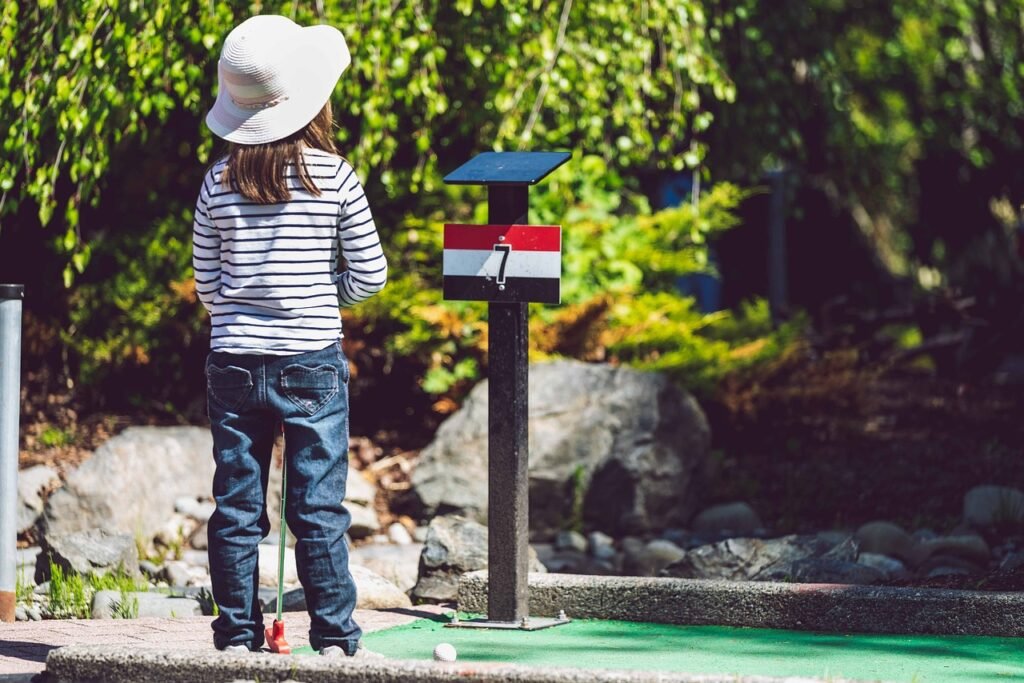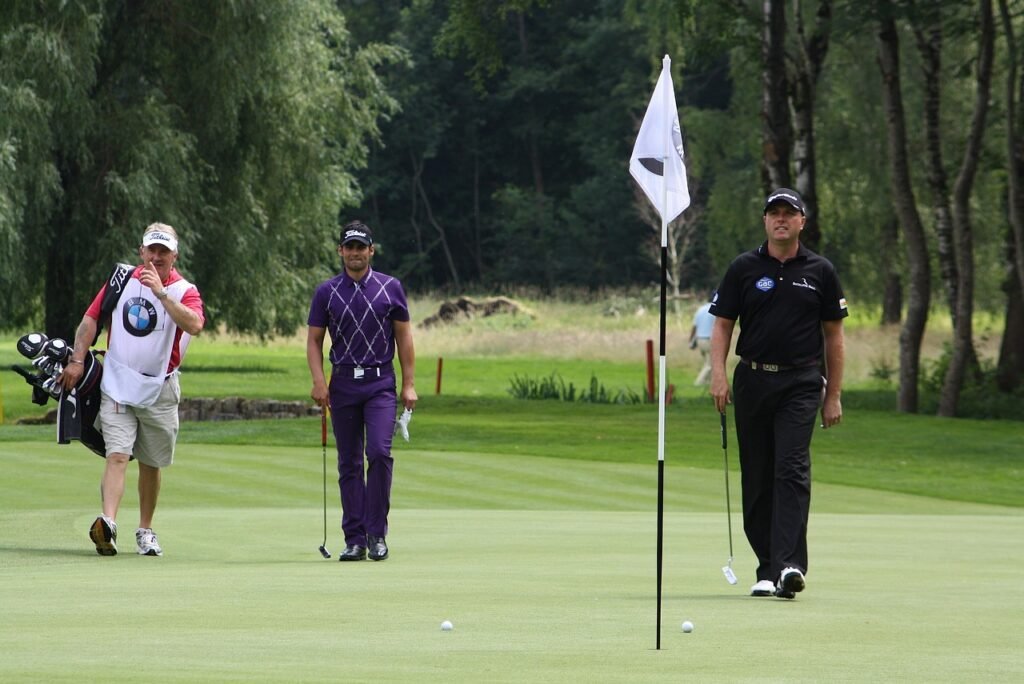Here’s an overview:
- Introduction: The Upcoming Wave of Miniature Golf: How Much Does a Mini Golf Course Cost to Build?
- History Meets Modernity: The Evolution of Mini Golf
- Fore! Casting the Budget: Types of Courses and Cost Implications
- Classic Courses
- Themed Courses
- High-Tech Courses
- Adventure and Extreme Courses
- Teeing Up Your Concept: Design and Theme Considerations
- Location, Location, Location: Choosing the Right Spot for Your Mini Golf Course
- Navigating Zoning Laws and Building Codes
- Zoning Laws
- Building Codes
- Additional Considerations
- The Green Scene: Artificial vs. Natural Landscaping Costs
- Artificial Landscaping
- Natural Landscaping
- Gearing Up: Sourcing High-Quality Course Materials
- Tapping Into Technology: The Role of Advanced Systems in Mini Golf
- Successful Staffing Strategies: Hiring and Training Your Team
- Hiring Process:
- Training Program:
- Marketing Your Mini Golf Course: Strategies to Swing Success
- Bearing the Brunt of Ongoing Expenses: Maintenance and Insurance
- Adding It All Up: A Complete Cost Summary
- From Concept to Course: A Timeline for Building Your Mini Golf Business
- Initial Planning (1-3 Months)
- Design Phase (2-4 Months)
- Construction Phase (3-6 Months)
- Pre-Opening (1-2 Months)
- Grand Opening
- Conclusion: Are You Ready to Take a Swing at Mini Golf Ownership?
Introduction: The Upcoming Wave of Miniature Golf: How Much Does a Mini Golf Course Cost to Build?
Miniature golf is on the rise, no longer relegated to beachside boardwalks and family vacation spots. Across towns and cities, entrepreneurs are catching onto the trend of creating themed, engaging mini-golf courses that attract a broad demographic. From Millennial date nights to Gen Z’s looking for IG-worthy locations, mini-golf is becoming a go-to for entertainment.
What’s more exciting is the evolution of mini-golf from the kitschy windmills of the past. Today’s courses are teeming with innovation—think technology-infused holes, creative storytelling through the course landscape, and a seamless fusion of art and leisure. These aren’t your grandpa’s putt-putt courses; they’re immersive experiences that blend play with spectacle.
The resurgence of mini-golf is also being fueled by a shift in consumer spending. As people seek more experiences over material goods, a round of mini-golf provides the perfect mix of activity, challenge, and social interaction. Plus, with customization options available, no two courses need look the same. Hosting birthday parties, corporate events, and even league play adds to the attraction’s versatility.
Budget-wise, building a miniature golf course can seem daunting, but with strategic planning and understanding of costs, it’s within reach. From land and design expenses to themes, obstacles, and ongoing maintenance—every penny counts.
So, in this garden of neon-lit loops and lush green lanes, what does it take to construct these pint-sized paradises? In this article, we’ll putter through the nuts and bolts of building not just a mini-golf course, but the next community cornerstone. We’re talking about breaking down the budget to understand what it really costs to stake a claim in this upcoming wave of miniature golf.
History Meets Modernity: The Evolution of Mini Golf

Once a mere offshoot of the genteel game of golf, mini golf, also known as putt-putt, has carved out its own quirky niche over the past century. The roots of miniature golf stretch back to the Ladies’ Putting Club of St. Andrews in Scotland, established in the 1860s. Yet, it was in the United States during the 1920s that mini golf truly began to flourish, evolving from simple greens with obstacles to the whimsical and imaginative courses we see today.
Course complexity and themes began to skyrocket in the mid-20th century. Gone were the days of rudimentary courses; instead, visionary course designers began incorporating castles, windmills, and even narrative-driven adventure holes. This reimagination of mini golf saw the addition of electrical gadgets, water features, and moving parts, all launched into mainstream popularity in the American leisure landscape.
In modern times, mini golf has morphed once again, embracing both tradition and high-tech with courses that weave through indoor and outdoor spaces seamlessly. There’s a clear inclination toward high-quality, durable materials, leading to escalating construction costs. Today’s mini-golf courses may include:
- Advanced lighting systems for evening play
- Interactive elements paired with smart technology
- Premium landscaping to simulate a real golf experience
- Durable, weather-resistant synthetic turf
- Themed audio and animatronics to enhance immersion
Yet, with the rise of digital entertainment, mini golf has had to reinvent itself to stay relevant. Enter glow-in-the-dark indoor courses, augmented reality applications, and social media-friendly photo ops that lure in a younger generation. The past and present collide, creating a vibrant future for an enduring pastime, each unique course reflecting a piece of mini golf’s storied history as it looks forward to a tech-savvy, whimsical future.
Fore! Casting the Budget: Types of Courses and Cost Implications
When diving into the world of miniature golf course construction, the type of course you choose to build has significant implications for your budget. Here’s how the costs can differ among various miniature golf course types:
Classic Courses
- Design Simplicity: Featuring windmills, clown mouths, and simple loops.
- Cost Effective: These traditional designs often require fewer high-cost materials and intricate landscaping.
- Average Cost: Building a classic course can range from $70,000 to $130,000 depending on land, size, and design.
Themed Courses
- Creative Elements: Pirate ships, jungle animals, or castle motifs provide an immersive experience.
- Increased Investment: The theming components like elaborate statues and décor can drive up costs.
- Average Cost: Themed courses usually start around $100,000, with the high-end easily reaching upwards of $300,000 or more.
High-Tech Courses
- Innovative Features: Integration of LED lighting, interactive obstacles, and digital scorekeeping.
- Technology Costs: The shinier, modern tech features can significantly grow the budget.
- Average Cost: Expect to invest anywhere from $150,000 to over $500,000 for the most advanced courses.
Adventure and Extreme Courses
- Elaborate Design: Incorporates landscapes that include waterfalls, caves, and multi-level holes.
- Custom Construction: Requires expert craftsmanship, leading to higher labor costs.
- Average Cost: These can be the priciest options, often surpassing $500,000 due to their complexity and scale.
When gauging the cost implications, also consider ongoing maintenance and operation expenses. Classic courses may be cheaper to maintain while high-tech and themed courses might incur higher operational costs due to the nature of their features and the need for regular updates or repairs. It’s critical to factor these into your long-term budgeting to ensure the sustainability of your miniature golf course business.
Teeing Up Your Concept: Design and Theme Considerations

When building a miniature golf course, the design and theme are not just aesthetic choices but strategic business decisions that can significantly impact the costs. Here’s how potential owners can navigate these considerations:
- Creativity vs. Complexity: A unique theme can set a course apart, but the more complex the design, the higher the budget. Owners must find the sweet spot between creativity and cost-effectiveness.
- Theme Consistency: A cohesive theme enhances player experience but requires thoughtful planning. Every hole, from the landscaping to the hazards, needs to reflect the central concept to avoid disjointedness, which can increase planning and construction costs.
- Landscape Integration: Leveraging the existing landscape can reduce costs. Incorporating natural features like hills, water bodies, or trees into the design can minimize excavation and construction expenses.
- Scalability: A modular design approach allows for future expansion or modifications without a complete overhaul. This forward-thinking strategy can save money in the long run, allowing you to scale up as your business grows.
- Materials and Durability: While upfront material costs are important, so is longevity. Choosing durable, weather-resistant materials can lower maintenance costs over time, even if the initial investment is higher.
- Technological Additions: Interactive elements or tech enhancements can attract a tech-savvy demographic but will increase initial costs. Owners need to assess whether the potential hike in patronage justifies the investment.
- Local Regulations: Compliance with local building codes and accessibility standards can influence design choices and incur additional costs, such as the need for specific pathways or ramps.
Considering these factors is crucial to ensuring that the design and theme of your miniature golf course align with the projected budget and business goals. The visual appeal and playability must be balanced with practical financial constraints to create a successful mini-golf venture.
Location, Location, Location: Choosing the Right Spot for Your Mini Golf Course
Finding the perfect location for your mini golf course is much like real estate hunting—it’s all about “location, location, location!” The right spot is key to the success of your venture, and several factors must be weighed with care.
- Visibility and Accessibility: A site easily seen from the road attracts passing traffic. Ample parking and easy access for visitors are non-negotiables for a successful operation. After all, if they can’t find you or park conveniently, they are less likely to visit.
- Demographics: Know your audience. Is your course targeting families, young adults, or tourists? Selecting a location near parks, family centers, or tourist attractions can bolster footfall. The local demographics should align with your planned customer base.
- Competition: It’s essential to survey the competitive landscape. Too close to another mini golf course and you’ll fight for the same clientele; too far from other attractions and you might be overlooked. Finding that sweet spot—ideally, an area with complementary businesses but no direct competitors—is strategic.
- Lease or Buy: Deciding whether to lease or buy impacts your budget considerably. Purchasing land offers more control but requires a larger upfront investment. Leasing, on the other hand, can reduce initial costs but may have long-term financial implications.
- Zoning and Regulations: Before you fall in love with a spot, ensure it’s zoned for commercial use and that you can obtain the required permits. Running into legal snags after committing to a location is both heartbreaking and costly.
Don’t forget, a well-chosen location not only increases foot traffic but also adds inherent advertising value—passersby become potential customers. Take your time, do the research, and you’ll set the foundation for a miniature golf course that’s above par from day one.
Navigating Zoning Laws and Building Codes
When embarking on the construction of a miniature golf course, understanding local zoning laws and building codes is critical and can significantly impact the budget. These regulations vary by location and navigate the allowable use of land for specific types of structures and businesses.
Zoning Laws
Zoning laws divide geographic areas into zones within which certain land uses are permitted or prohibited. Before purchasing land or beginning construction, one must ensure that the intended use aligns with local zoning regulations.
- Research: Start by consulting with your local zoning office to determine the correct zoning classification for a miniature golf course.
- Consult Professional Help: Consider hiring a zoning attorney or land use consultant who can navigate any complexities and offer guidance on obtaining necessary variances or permits.
Building Codes
Building codes ensure that structures are safe and meet minimum construction standards. They cover a range of factors, including:
- Electrical wiring
- Plumbing
- Accessibility
- Structural integrity
- Stay Updated: Codes are updated regularly and vary by municipality. Keep abreast of the latest changes related to recreational facilities.
- Permit Process: Securing permits is often a multi-step process, involving detailed plans and occasionally, public hearings.
- Inspections: Comply with inspection requirements throughout the construction process to avoid costly retrofits or delays.
Additional Considerations
- Environmental Regulations: Be aware of any environmental protections or restrictions that may come into play.
- Parking Requirements: Depending on the size of your course, there may be specific mandates for parking facilities.
In summary, ensuring compliance with zoning laws and building codes is crucial and can have considerable financial implications. Factor these costs into the overall budget, and maintain a contingency fund to address any unexpected regulatory hurdles that may arise during development.
The Green Scene: Artificial vs. Natural Landscaping Costs

When designing a miniature golf course, the decision between artificial and natural landscaping is pivotal and comes with distinct cost implications.
Artificial Landscaping
Initially, artificial landscaping may seem costly, but it’s a game of long-term savings. Here’s a breakdown:
- Purchase and Installation: High-quality synthetic turf runs from $5 to $20 per square foot. Including installation, costs can soar to $15,000 for the average course.
- Maintenance: Virtually non-existent. No watering, mowing, or fertilizing, so yearly costs are minimal.
- Durability: With a life expectancy of 15-20 years, artificial landscaping stands the test of time.
- Aesthetics: Consistently lush-looking spaces regardless of the season.
Natural Landscaping
While the initial receipt for natural landscaping might be lighter on the wallet, ongoing expenditures stack up.
- Purchase and Installation: The cost of sod, plants, and trees might be as low as $3 to $10 per square foot but don’t forget the labor for planting.
- Maintenance: The real kicker here is the ongoing care. Watering, mowing, and gardeners can cost hundreds, if not thousands, annually.
- Durability: Natural grass requires seasonal rejuvenation and can be damaged easily, racking up repair costs.
- Aesthetics: Offers authentic charm, but keeping it pristine is a herculean task that comes with its price tag.
In the end, the choice hinges on immediate budget versus long-term investment and the desired aesthetic. Each landscaping type shapes not just the course’s budget but also its character and the amount of ongoing attention it will demand.
Gearing Up: Sourcing High-Quality Course Materials
For anyone serious about constructing a miniature golf course, understanding that quality materials equate to longevity and player satisfaction is key. Here’s the scoop on hitting the sweet spot between cost and quality.
First, the basics are a must — think turf, putters, and balls. High-grade synthetic turf offers a realistic playing surface with minimal upkeep. Skipping on quality may lead to early wear and tear, which means added costs down the line for repairs or a full-blown do-over. When it comes to putters and balls, durability is the name of the game. Heavy-duty options exist that won’t fade after a summer’s worth of intense mini-golf sessions.
- Turf: Aim for one with a high stitch count for durability.
- Putters: Invest in rubber grips and sturdy shafts.
- Balls: Opt for UV-resistant ones to prevent discoloration.
Next up, obstacles and décor. These are the heart and soul of a course. Unique and challenging features will keep customers returning. Sourcing from a reputable supplier ensuring these elements can withstand the elements is smart business.
- Obstacles: Choose weather-resistant and low-maintenance materials.
- Décor: Look for vibrant, fade-resistant paint and hardy construction.
Don’t forget the infrastructure. Weatherproofing elements like drainage systems and lighting can save heaps in future repairs and ensure uninterrupted operation.
- Drainage: Opt for a robust system to prevent waterlogging.
- Lighting: LED options are energy-efficient and have a longer lifespan.
Remember, it’s the little details that can make or break a miniature golf course. Quality materials might cost more upfront, but they pay for themselves in reduced maintenance needs and increased customer satisfaction. It’s an investment where cutting corners simply doesn’t pay off in the end.
Tapping Into Technology: The Role of Advanced Systems in Mini Golf
Integrating advanced technology into mini golf courses has become increasingly popular, significantly impacting construction and operational budgets. These systems not only enhance the player experience but often streamline course management. Here are some ways technology is changing the mini golf landscape:
- Interactive Elements: Nowadays, a simple putt-putt is not enough to wow the audience. Courses may feature sensors and triggers that animate obstacles or provide special effects, bringing each hole to life. Integrating such features requires a robust budget line for both hardware and software development.
- Mobile Connectivity: Apps can be developed to keep score, navigate the course, or even offer augmented reality challenges. However, app development and maintenance are ongoing costs that can impact initial budgets and require updates and customer support.
- Advanced Lighting Systems: LED and smart lighting can transform a game of mini golf into a glowing nighttime adventure. Although energy-efficient in the long run, the upfront cost of advanced lighting systems can be considerable.
- Automated Maintenance: Robotics and automation technology can keep the greens pristine without constant human attention, but the upfront investment in such technology needs to be accounted for.
- Payment Systems: Gone are the days of cash-only operations. Electronic payment systems, including contactless and mobile payments, add convenience but require installation, maintenance, and transaction fees.
- Marketing Integrations: Digital marketing tools and data analysis systems can target potential visitors more effectively and enhance business operations, yet they also bring an additional layer of expense.
All these high-tech systems contribute to the appeal and efficiency of modern mini golf courses, but they require significant capital. Owners must carefully consider these costs when planning and budgeting for a successful course.
Successful Staffing Strategies: Hiring and Training Your Team

When building a miniature golf course, staffing is a crucial component not to be underestimated in your budget. Effective hiring and training ensure smooth operations and a positive customer experience. Start by understanding the roles required: customer service representatives, course attendants, and possibly a manager, each bringing a unique set of skills to your business.
First, establish clear job descriptions to attract the right candidates. Focus on personal traits like friendliness and reliability, as much as on prior experience. Use online job platforms and local community boards to cast a wide recruitment net.
Hiring Process:
- Craft precise job listings to attract candidates who align with your business values.
- Consider group interviews to gauge interpersonal skills, especially for customer-facing roles.
- Opt for role-playing scenarios to assess problem-solving capabilities.
Once you’ve selected your team, an effective training program is key to equip them with the necessary skills and knowledge.
Training Program:
- Orientation: Introduce them to the mission, culture, and expectations of your business.
- Operations Training: Walk them through daily procedures, safety protocols, and customer service standards.
- Role-specific Training: Each position might require tailored training; for instance, course attendants must know the ins and outs of the golf course for maintenance and troubleshooting.
Remember, your staff represents your brand. Continuous training and opportunities for feedback keep your team engaged and up-to-date. Include all these aspects in your budget, as the return on investment for well-trained staff leads to happier customers, better reviews, and repeat business.
Marketing Your Mini Golf Course: Strategies to Swing Success
Marketing is a critical part of ensuring the profitability of your mini golf course. To capture the attention of potential visitors, you need to employ a mix of innovative and traditional marketing strategies. Here are several actionable tactics:
- Utilize Social Media: Create engaging content for platforms like Facebook, Instagram, and TikTok. Share fun photos and videos of your course, create hashtag campaigns, and engage with your audience to build a community around your mini golf course.
- Offer Promotions and Discounts: Attract new customers with opening specials, seasonal discounts, or group rates. Consider partnering with local businesses or schools to offer packages.
- Host Special Events: Plan themed nights, tournaments, or charity events to draw in crowds. These can generate publicity and give people a reason to come back.
- Engage in Local SEO: Ensure your business shows up on Google Maps and in local searches. Use keywords that potential visitors might use when looking for mini golf options nearby.
- Leverage Word of Mouth: Encourage happy guests to write reviews online or bring friends next time. Positive word of mouth can be potent, especially when it comes to local entertainment options.
- Develop a Loyalty Program: Reward repeat customers with a loyalty program that offers benefits or discounts after a certain number of visits.
- Create a Dynamic Website: Provide all the information potential customers might need—hours, pricing, location, contact info—and integrate an online booking system for convenience.
- Invest in Signage: Eye-catching signs can draw in passersby. Ensure they are strategically placed and visible from main roads or local attractions.
- Partner with Influencers: Collaborate with local influencers or bloggers who can showcase your mini golf course to their followers.
By implementing these strategies, you’re paving the way towards a hole-in-one in the competitive mini golf industry. The goal is to create an experience that people want to be part of, talk about, and return to, ensuring your course remains a hit both off and online.
Bearing the Brunt of Ongoing Expenses: Maintenance and Insurance

Owning a miniature golf course isn’t all about sunny days and hole-in-ones; it involves regular maintenance and proper insurance to ensure longevity and protection from various risks.
Let’s tee off with maintenance. Mini golf courses require daily upkeep to remain attractive and functional. Here are some key tasks:
- Landscaping: Mowing lawns, trimming hedges, and maintaining decorative plants are must-dos, especially during the growing season.
- Putting Greens Care: The synthetic surfaces need regular cleaning and inspection to prevent wear and tear.
- Water Features: Ponds and fountains require algae control, pump maintenance, and periodic cleaning.
- Theme Elements: Those quirky windmills and loop-de-loops? They need a check-up too, ensuring mechanisms function smoothly.
Of course, harsh weather or unexpected events can lead to additional repairs. It pays to have a contingency fund for such surprises.
Moving onto insurance, it’s more than just a safety net—it’s a must-have. Why? Because accidents happen. A stray golf ball, a slippery surface, or even an equipment malfunction can lead to injuries or property damage. Here’s a rundown of typical insurance coverages that course owners should consider:
- Liability Insurance: Covers injury claims from patrons and protects against property damage lawsuits.
- Property Insurance: Safeguards structures and equipment against fire, theft, and natural disasters.
- Worker’s Compensation: A necessary policy if you employ staff for the day-to-day running of the course.
Remember, premiums vary widely, depending on factors like location, coverage limits, and deductible levels. It’s wise to shop around and consult with an insurance specialist who understands the unique needs of recreational facilities. Consider it an essential line item in your budget—the cost of peace of mind, ensuring you can focus on the fun.
maintenance and insurance are not one-time expenses but ongoing commitments that ensure the miniature golf course remains a well-oiled machine, ready to entertain putters of all ages for years to come.
Adding It All Up: A Complete Cost Summary

When eyeballing the financials for setting up a miniature golf course, it’s like piecing together a jigsaw puzzle. Now that we’ve pored over each element, let’s stack up the numbers and see the bigger picture.
First off, we have the land acquisition or rental costs. Depending on location, this might set one back anywhere from a few thousand to millions. Next up, designing the course isn’t child’s play; professional fees for architects can swing from $5,000 to $50,000.
Gone are the days when a few windmills and clown mouths cut it. Modern mini-golf-goers are after a quirky adventure, which means spending on theming might dribble between $10,000 to $100,000 or even more, particularly if one’s gunning for a full-scale pirate ship or a mock-up castle.
Now, let’s talk greens. The synthetic turf, with all its underlayers and putt-ability, isn’t cheap. Expect to cough up anywhere from $2 to $15 per square foot, and yes, that’s just for the ground beneath your feet.
Don’t forget about obstacles, props, and signage—critical players in any mini-golf ensemble. They’ll run a tab of around $1,000 to $5,000, depending on how zany one goes. Moreover, lighting systems and landscaping, which ensure the venue looks snazzy day and night, can propel the budget by an additional $10,000 to $50,000.
And, of course, the club house or reception area where customers fork out for the fun—outfitting this space might require an infusion from $20,000 to upwards of $100,000.
All things considered, for someone stepping onto the mini-golf course creation fairway, they should budget for a putt-totaling anywhere between $200,000 and $500,000. Now, that’s quite the financial round, isn’t it?
From Concept to Course: A Timeline for Building Your Mini Golf Business
Building a mini golf business begins with a dream, but turning that concept into a fully operating course is a process that requires planning, investment, and a bit of creativity. Here’s a rough timeline that can guide you through the journey from idea to the first tee-off.
Initial Planning (1-3 Months)
- Conceptualization: Define your mini golf course theme, features, and the unique experience you want to provide.
- Market Research: Analyze competitors, location demographics, and demand for mini golf in your intended area.
- Feasibility Study: Determine if your vision is financially sensible and sustainable.
Design Phase (2-4 Months)
- Hire a Designer: Collaborate with an experienced mini golf course designer to create a detailed plan.
- Course Layout: Work on the course footprint, considering the natural terrain and any existing structures.
- Obtain Permits: Secure the necessary permissions from local authorities before breaking ground.
Construction Phase (3-6 Months)
- Site Preparation: Clear, grade, and potentially landscape the course area in readiness for installation.
- Construct Features: Start building the holes, water features, lighting, and decorative elements.
- Amenities Installation: In parallel, construct the clubhouse, restrooms, and other facilities essential to the operation.
Pre-Opening (1-2 Months)
- Hiring Staff: Recruit and train employees who will manage the day-to-day operations.
- Marketing Push: Ramp up advertising efforts to build anticipation and inform the local community.
- Soft Launch: Consider a test run with invited guests to gather feedback and refine the customer experience.
Grand Opening
- Launch Event: Organize an opening day event with promotions to attract your first wave of customers.
- Monitor & Improve: Collect customer feedback and continuously make adjustments for improvement.
Remember, these stages may overlap, and unexpected delays can alter the timeline. Patience and flexibility in planning and execution are key to creating a mini golf course that’s both fun and financially successful.
Conclusion: Are You Ready to Take a Swing at Mini Golf Ownership?
Deciding to leap into mini golf course ownership is no small feat. You’ve seen the numbers: land costs, construction expenses, theming designs, staff wages, maintenance bills, marketing charges, and the unforeseen expenditures that invariably pop up. But beyond dollars and cents, this venture requires dedication, a penchant for hospitality, and a love for family fun that endures through seasons and trends.
Before you dive in, check again that your checklist is marked off:
- Research: Have you scoped out the competition and potential market?
- Budget: Is your financial plan robust, with room for unpredictability?
- Theme: Does your concept stand out, yet resonate with a broad audience?
- Location: Have you secured a spot that’s visible and easily accessible?
- Construction: Are reliable contractors lined up and designs finalized?
- Operations: Do you have a plan for staffing, managing, and day-to-day tasks?
- Marketing: Have strategies to create buzz and draw in customers been developed?
- Long-term vision: Are you prepared for seasonal fluctuations and future expansions?
Having ticked all these boxes, you’re not just buying into a business; you’re stepping onto the green as a curator of joy, a maestro of putts, and, perhaps, the community’s next favorite hangout. It’s not just about having the financial wherewithal; it’s about having the heart and the drive to make your mini golf course a hole-in-one success.
So grab your putter, stead your nerves, and take that swing. Mini golf ownership could be the business adventure of a lifetime – are you ready for the challenge?
Exploring the costs involved in building a mini-golf course? It’s useful to compare these costs to those of constructing a full-sized golf course. Understanding the financial requirements for a standard golf course can provide valuable context for your mini-golf project, from land acquisition to design and landscaping. For a detailed breakdown of what it might cost to build a standard golf course, check out this resource: How Much Does It Cost to Build a Golf Course.
